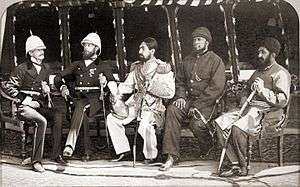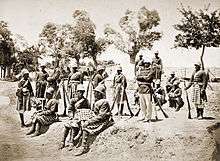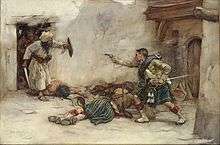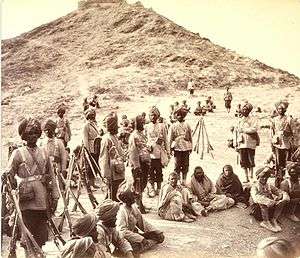Second Anglo-Afghan War
| Second Anglo–Afghan War | |||||||
|---|---|---|---|---|---|---|---|
| Part of The Great Game | |||||||
 92nd Highlanders at Kandahar. Oil by Richard Caton Woodville | |||||||
| |||||||
| Belligerents | |||||||
|
| |||||||
| Commanders and leaders | |||||||
|
|
| ||||||
| Casualties and losses | |||||||
|
5,000+ killed in major battles Total unknown[6] |
1,850 killed in action or died of wounds 8,000 died of diseases[6] | ||||||
The Second Anglo–Afghan War (Pashto: د افغان-انګرېز دويمه جګړه) was fought between the British Raj and the Emirate of Afghanistan from 1878 to 1880, when the latter was ruled by Sher Ali Khan of the Barakzai dynasty, the son of former Emir Dost Mohammad Khan. This was the second time British India invaded Afghanistan. The war ended after the British emerged victorious against the Afghan rebels and the Afghans agreed to let the British attain all of their geopolitical objectives from the Treaty of Gandamak. Most of the British and Indian soldiers withdrew from Afghanistan. The Afghan tribes were permitted to maintain internal rule and local customs but they had to cede control of the area's foreign relations to the British, who, in turn, guaranteed the area's freedom from foreign military domination. This was aimed to thwart expansion by the Russian Empire into India.[4][5]
War
Background
After tension between Russia and Britain in Europe ended with the June 1878 Congress of Berlin, Russia turned its attention to Central Asia. That same summer, Russia sent an uninvited diplomatic mission to Kabul. Sher Ali Khan, the Amir of Afghanistan, tried unsuccessfully to keep them out. Russian envoys arrived in Kabul on 22 July 1878, and on 14 August, the British demanded that Sher Ali accept a British mission too.[7]
The Amir not only refused to receive a British mission under Neville Bowles Chamberlain, but threatened to stop it if it were dispatched. Lord Lytton, the viceroy, ordered a diplomatic mission to set out for Kabul in September 1878 but the mission was turned back as it approached the eastern entrance of the Khyber Pass, triggering the Second Anglo–Afghan War.[7]
First phase
A British force of about 50,000 fighting men, mostly Indians, was distributed into military columns which penetrated Afghanistan at three different points. An alarmed Sher Ali attempted to appeal in person to the Russian Tsar for assistance, but unable to do so, he returned to Mazar-i-Sharif, where he died on 21 February 1879.[8]

Treaty
With British forces occupying much of the country, Sher Ali's son and successor, Mohammad Yaqub Khan, signed the Treaty of Gandamak in May 1879 to prevent a British invasion of the rest of the country. According to this agreement and in return for an annual subsidy and vague assurances of assistance in case of foreign aggression, Yaqub relinquished control of Afghan foreign affairs to Britain. British representatives were installed in Kabul and other locations, British control was extended to the Khyber and Michni passes, and Afghanistan ceded various North-West Frontier Province areas and Quetta to Britain. The British Army then withdrew.[9]
However, on 3 September 1879 an uprising in Kabul led to the slaughter of Sir Louis Cavagnari, the British representative, along with his guards, and staff – provoking the next phase of the Second Afghan War.[10]
Second phase
_WDL11496.png)
Major General Sir Frederick Roberts led the Kabul Field Force over the Shutargardan Pass into central Afghanistan, defeated the Afghan Army at Char Asiab on 6 October 1879, and occupied Kabul two days later.[11] Ghazi Mohammad Jan Khan Wardak, and a force of 10,000 Afghans, staged an uprising and attacked British forces near Kabul in the Siege of the Sherpur Cantonment in December 1879. Despite besieging the British garrison there, he failed to maintain the Siege of Sherpur, instead shifting focus to Roberts' force, and this resulted in the collapse of this rebellion. Yaqub Khan, suspected of complicity in the massacre of Cavagnari and his staff, was obliged to abdicate. The British considered a number of possible political settlements, including partitioning Afghanistan between multiple rulers or placing Yaqub's brother Ayub Khan on the throne, but ultimately decided to install his cousin Abdur Rahman Khan as emir instead.[12][13]
Ayub Khan, who had been serving as governor of Herat, rose in revolt, defeated a British detachment at the Battle of Maiwand in July 1880 and besieged Kandahar. Roberts then led the main British force from Kabul and decisively defeated Ayub Khan on 1 September at the Battle of Kandahar, bringing his rebellion to an end.[12] Abdur Rahman had confirmed the Treaty of Gandamak, leaving the British in control of the territories ceded by Yaqub Khan and ensuring British control of Afghanistan's foreign policy in exchange for protection and a subsidy.[14]
Abandoning the provocative policy of maintaining a British resident in Kabul, but having achieved all their other objectives, the British withdrew.[12]
Captured British and Indian soldiers
The British officer John Masters recorded in his autobiography that Afghan women in the North-West Frontier Province of British India during the Second Anglo-Afghan War would castrate non-Muslim soldiers who were captured, like British and Sikhs.[15][16] They also used an execution method involving urine; Pathan women urinated into prisoner's mouths.[17] Captured British soldiers were spread out and fastened with restraints to the ground, then a stick, or a piece of wood was used to keep their mouth open to prevent swallowing. Pathan women then squatted and urinated directly into the mouth of the man until he drowned in the urine, taking turns one at a time.[18][19][20][21][22][23][24]
Timeline of battles
There were several decisive actions in the Second Anglo–Afghan War, from 1878 to 1880. Here are the battles and actions in chronological order. An asterisk (*) indicates a clasp was awarded for that particular battle with the Afghanistan Medal.



1878
- Battle of Ali Masjid* (British victory)
- Battle of Peiwar Kotal* (British victory)
1879
- Action at Takht-i-Pul (British victory)
- Action at Matun (British victory)
- Battle of Khushk-i-Nakud (British victory)
- Battle of Fatehabad (British victory)
- Battle of Kam Dakka (Afghan victory)
- Battle of Charasiab* (British victory)[25]
- Battle of Shajui
- Battle of Karez Mir
- Battle of Takht-i-Shah
- Battle of Asmai Heights* (Afghan victory)
- Siege of Sherpur* (British victory)
1880
- Battle of Ahmed Khel* (British victory)
- Battle of Arzu
- Second Battle of Charasiab
- Battle of Maiwand (Afghan victory)
- Battle of Deh Koja (Afghan Victory)
- Battle of Kandahar* (British victory)
1881
- Kandahar (and Afghanistan) Evacuation
Order of battle





- Peshawar Valley Field Force Lieutenant General Sir Samuel Browne
- Cavalry Brigade Brigadier General C. J. S. Gough
- 10th Hussars (2 Sqdns)
- 11th Probyn's Lancers
- Guides Cavalry
- Royal Artillery
- First Infantry Brigade Brigadier General H. T. Macpherson
- 4th Battalion Rifle Brigade
- 20th Brownlow's Punjabis
- 4th Gurkha Rifles
- Second Infantry Brigade Brigadier General J. A. Tytler
- 1st Battalion Leicestershire Regiment
- Queen's Own Corps of Guides (infantry component)
- 51st Sikhs
- Third Infantry Brigade Brigadier General F. Appleyard
- Fourth Infantry Brigade Brigadier General W. Browne
- Cavalry Brigade Brigadier General C. J. S. Gough
- Kurram Valley Field Force Major General Roberts
- Cavalry Brigade Brigadier General Hugh Gough
- 10th Hussars (1 sqdn)
- 12th Cavalry
- 25th Cavalry
- Royal Artillery Colonel A. H. Lindsay
- First Infantry Brigade Brigadier General A. H. Cobbe
- 2nd Battalion, 8th Foot
- 23rd Pioneers
- 29th Punjabis
- 58th Vaughan's Rifles
- Second Infantry Brigade Brigadier General J. B. Thelwell
- Cavalry Brigade Brigadier General Hugh Gough
- Kandahar Field Force
- First Division Lieutenant General Donald Stewart
- Cavalry Brigade Brigadier General Walter Fane
- Royal Artillery Brigadier General C. G. Arbuthnot
- First Infantry Brigade Brigadier General R. Barter
- 2nd Battalion King's Royal Rifles
- 15th Sikhs
- 25th Punjabis
- Second Infantry Brigade Brigadier General W. Hughes
- 59th East Lancashire Regiment
- 12th Kelat-i-Ghilzai Regiment
- 1st Gurkha Rifles
- 3rd Gurkha Rifles
- 2nd Division Major General M A Biddulph
- Cavalry Brigade Brigadier General C. H. Palliser
- Artillery Colonel Le Mesurier
- First Infantry Brigade Brigadier General R. Lacy
- Second Infantry Brigade Brigadier General Nuttall
- First Division Lieutenant General Donald Stewart
See also
| Wikisource has original text related to this article: |
- First Anglo-Afghan War
- Third Anglo-Afghan War
- European influence in Afghanistan
- Military history of Afghanistan
- Tournament of Shadows
References
- ↑ Schmidt, Karl J. (1995). An Atlas and Survey of South Asian History. M.E. Sharpe. p. 74. ISBN 978-1563243332.
- ↑ Adamec, L.W.; Norris, J.A., Anglo-Afghan Wars, in Encyclopædia Iranica, online ed., 2010
- ↑ Norris, J.A., Anglo-Afghan Relations, in Encyclopædia Iranica, online ed., 2010
- 1 2 Barfield, Thomas (2010). Afghanistan: A Cultural and Political History. Princeton University Press. p. 145. ISBN 978-0-691-14568-6. Retrieved 22 August 2010.
- 1 2 Posturee, Bad (2002). Understanding Holocausts: How, Why and When They Occur. iUniverse. p. 84. ISBN 978-0-595-23838-5. Retrieved 22 August 2010.
- 1 2 Robson, Brian. (2007). The Road to Kabul: The Second Afghan War 1878–1881. Stroud: Spellmount. p. 299. ISBN 978-1-86227-416-7.
- 1 2 Barthorp, Michael (2002) [1982]. Afghan Wars and the North-West Frontier 1839–1947. London: Cassell. pp. 66–67. ISBN 0-304-36294-8.
- ↑ Hanna, Henry Bathurst (1904). The Second Afghan War, 1878-79-80: Its Causes, Its Conduct and Its Consequences. 2. Archibald Constable & Co. pp. 150–155.
- ↑ Barthorp, Michael (2002) [1982]. Afghan Wars and the North-West Frontier 1839–1947. London: Cassell. p. 71. ISBN 0-304-36294-8.
- ↑ Wilkinson-Latham, Robert (1998) [1977]. North-West Frontier 1837–1947. London: Osprey Publishing. p. 15. ISBN 0-85045-275-9.
- ↑ Barthorp, Michael (2002) [1982]. Afghan Wars and the North-West Frontier 1839–1947. London: Cassell. pp. 77–79. ISBN 0-304-36294-8.
- 1 2 3 Wilkinson-Latham, Robert (1998) [1977]. North-West Frontier 1837–1947. London: Osprey Publishing. pp. 16–17. ISBN 0-85045-275-9.
- ↑ Barthorp, Michael (2002) [1982]. Afghan Wars and the North-West Frontier 1839–1947. London: Cassell. pp. 81–85. ISBN 0-304-36294-8.
- ↑ Barthorp, Michael (2002) [1982]. Afghan Wars and the North-West Frontier 1839–1947. London: Cassell. pp. 85–90. ISBN 0-304-36294-8.
- ↑ Masters, John (1956). Bugles and a Tiger: A Volume of Autobiography. Viking Press. p. 190. Retrieved 5 April 2011.
- ↑ Barthorp, Michael; Anderson, Dougas N. (1996). The Frontier Ablaze: The North-West Frontier Rising, 1897–98. Windrow & Greene. p. 12. ISBN 1-85915-023-3. Retrieved 5 April 2011.
- ↑ Devereux, George (1976). Dreams in Greek Tragedy: An Ethno-psycho-analytical Study. University of California Press. p. 237. ISBN 0-520-02921-6. Retrieved 5 April 2011.
- ↑ Masters, John (1956). Bugles and a Tiger: A Volume of Autobiography. Viking Press. p. 190. Retrieved 5 April 2011.
- ↑ Miller, Charles (1977). Khyber, British India's North West Frontier: The Story of an Imperial Migraine. Macdonald and Jane's. p. 359. ISBN 0-354-04167-3. Retrieved 5 April 2011.
- ↑ Richards, Donald Sydney (1990). The Savage Frontier: A History of the Anglo-Afghan Wars. Macmillan. p. 182. ISBN 0-333-52557-4. Retrieved 5 April 2011.
- ↑ Trench, Charles Chenevix (1985). The Frontier Scouts. Cape. ISBN 0-224-02321-7. Retrieved 5 April 2011.
- ↑ Mahle, H.S. (1985). Indo-Anglian Fiction: Some Perceptions: Including Some Lectures on Karnadʾs Tughlaq. Jainsons Publications. p. 24. Retrieved 5 April 2011.
- ↑ Clay, John (1992). John Masters: A Regimented Life. University of Michigan: Michael Joseph. p. 62. ISBN 0-7181-2945-8. Retrieved 5 April 2011.
- ↑ Masters, John (June 13, 2002). Bugles and a Tiger. Cassell Military (June 13, 2002). p. 190. ISBN 0-304-36156-9. Retrieved 5 April 2011.
- ↑ Alikuzai, Hamid Wahed (2013). A Concise History of Afghanistan in 25 Volumes, Volume 14. Trafford Publishing. p. 594. ISBN 1490714413.
Bibliography
- Barthorp, Michael. 2002. Afghan Wars and the North-West Frontier 1839–1947. Cassell. London. ISBN 0-304-36294-8
- Gathorne-Hardy, Gathorne (1878). The Afghan War. Publications of the National Union. Westminster: National Union of Conservative and Constitutional Associations.
- Walker, Phillip Francis. Afghanistan: A Short Account of Afghanistan, Its History, and Our Dealings with It. London: Griffith and Farran (1881).
- Wilkinson-Latham, Robert. 1977. North-West Frontier 1837–1947. Osprey Publishing. London. ISBN 0-85045-275-9
External links
| Wikimedia Commons has media related to Second Anglo-Afghan War. |
- Second Anglo-Afghan War 1878–1880
- Second Anglo-Afghan War Chronology
- British Battles
- Online Afghan Calendar with Historical dates
- Frederick Roberts and the long road to Kandahar
- Anne S. K. Brown Military Collection, Brown University Library William Simpson's diary and album of sketches and watercolors covering the early part of the campaign, and done for the Illustrated London News
- Afghanistan & the British Raj : The Second Afghan War & its Aftermath From the Royal Geographical Society of South Australia blog entries for Afghanistan & the British Raj that cover the subject chronologically with images through reference works in our collection.
